Page 245 of 570
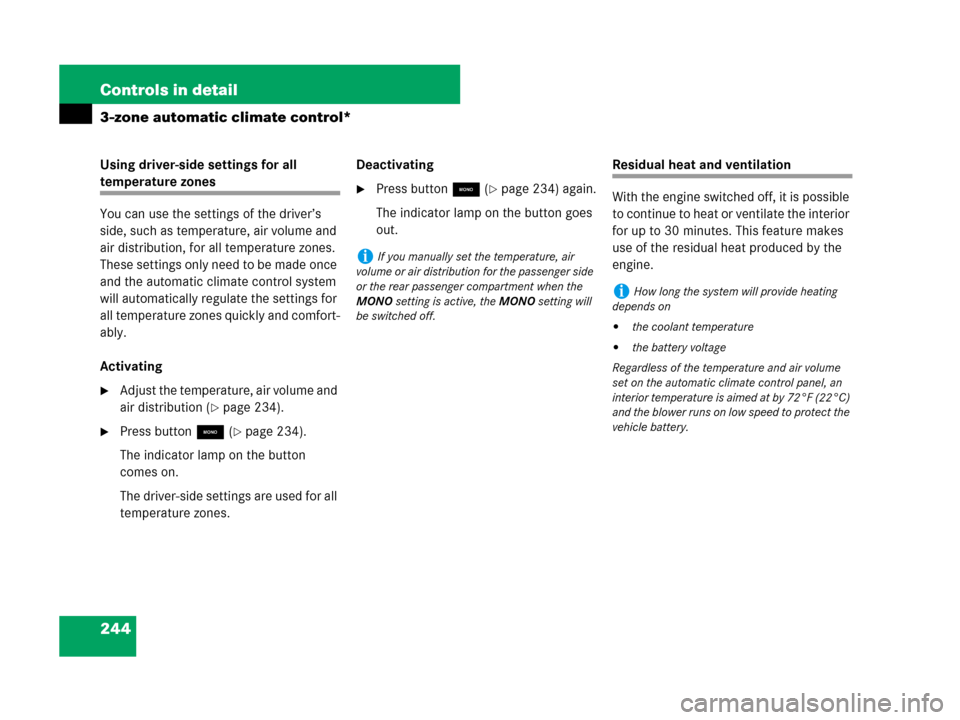
244 Controls in detail
3-zone automatic climate control*
Using driver-side settings for all
temperature zones
You can use the settings of the driver’s
side, such as temperature, air volume and
air distribution, for all temperature zones.
These settings only need to be made once
and the automatic climate control system
will automatically regulate the settings for
all temperature zones quickly and comfort-
ably.
Activating
�Adjust the temperature, air volume and
air distribution (
�page 234).
�Press button; (�page 234).
The indicator lamp on the button
comes on.
The driver-side settings are used for all
temperature zones.Deactivating
�Press button; (�page 234) again.
The indicator lamp on the button goes
out.
Residual heat and ventilation
With the engine switched off, it is possible
to continue to heat or ventilate the interior
for up to 30 minutes. This feature makes
use of the residual heat produced by the
engine.
iIf you manually set the temperature, air
volume or air distribution for the passenger side
or the rear passenger compartment when the
MONO setting is active, the MONO setting will
be switched off.
iHow long the system will provide heating
depends on
�the coolant temperature
�the battery voltage
Regardless of the temperature and air volume
set on the automatic climate control panel, an
interior temperature is aimed at by 72°F (22°C)
and the blower runs on low speed to protect the
vehicle battery.
Page 360 of 570
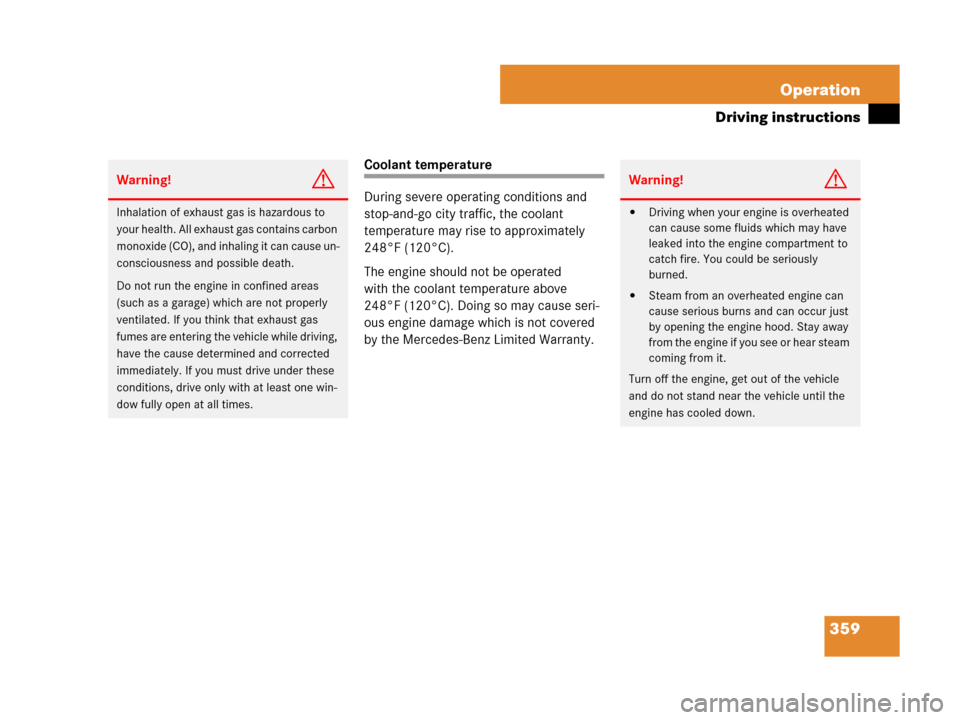
359 Operation
Driving instructions
Coolant temperature
During severe operating conditions and
stop-and-go city traffic, the coolant
temperature may rise to approximately
248°F (120°C).
The engine should not be operated
with the coolant temperature above
248°F (120°C). Doing so may cause seri-
ous engine damage which is not covered
by the Mercedes-Benz Limited Warranty.
Warning!G
Inhalation of exhaust gas is hazardous to
your health. All exhaust gas contains carbon
monoxide (CO), and inhaling it can cause un-
consciousness and possible death.
Do not run the engine in confined areas
(such as a garage) which are not properly
ventilated. If you think that exhaust gas
fumes are entering the vehicle while driving,
have the cause determined and corrected
immediately. If you must drive under these
conditions, drive only with at least one win-
dow fully open at all times.
Warning!G
�Driving when your engine is overheated
can cause some fluids which may have
leaked into the engine compartment to
catch fire. You could be seriously
burned.
�Steam from an overheated engine can
cause serious burns and can occur just
by opening the engine hood. Stay away
from the engine if you see or hear steam
coming from it.
Turn off the engine, get out of the vehicle
and do not stand near the vehicle until the
engine has cooled down.
Page 363 of 570
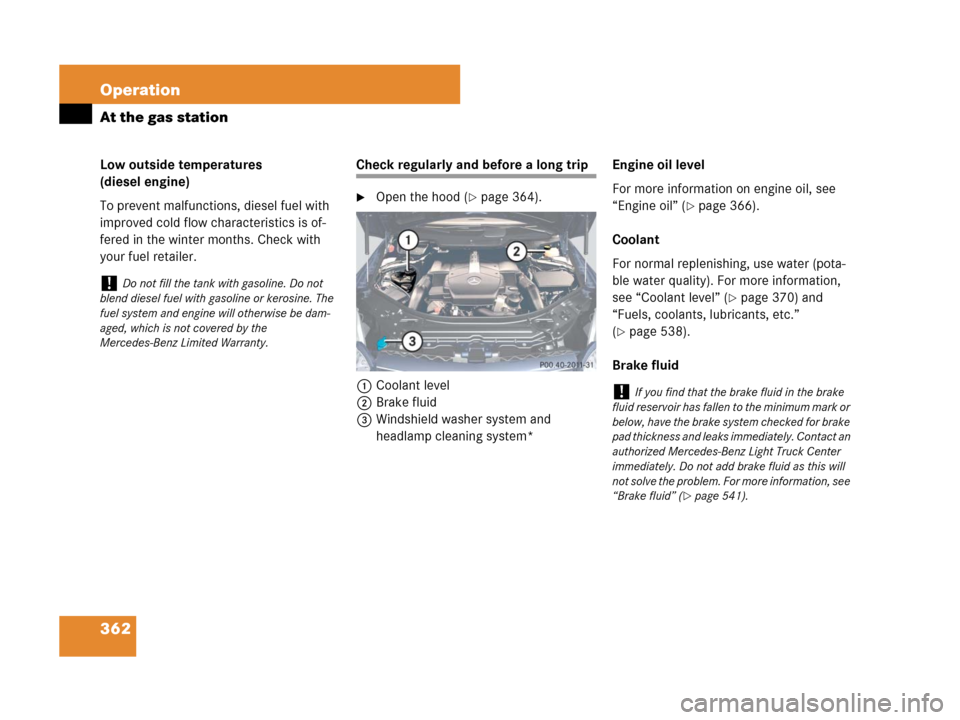
362 Operation
At the gas station
Low outside temperatures
(diesel engine)
To prevent malfunctions, diesel fuel with
improved cold flow characteristics is of-
fered in the winter months. Check with
your fuel retailer.Check regularly and before a long trip
�Open the hood (�page 364).
1Coolant level
2Brake fluid
3Windshield washer system and
headlamp cleaning system*Engine oil level
For more information on engine oil, see
“Engine oil” (�page 366).
Coolant
For normal replenishing, use water (pota-
ble water quality). For more information,
see “Coolant level” (
�page 370) and
“Fuels, coolants, lubricants, etc.”
(
�page 538).
Brake fluid
!Do not fill the tank with gasoline. Do not
blend diesel fuel with gasoline or kerosine. The
fuel system and engine will otherwise be dam-
aged, which is not covered by the
Mercedes-Benz Limited Warranty.
!If you find that the brake fluid in the brake
fluid reservoir has fallen to the minimum mark or
below, have the brake system checked for brake
pad thickness and leaks immediately. Contact an
authorized Mercedes-Benz Light Truck Center
immediately. Do not add brake fluid as this will
not solve the problem. For more information, see
“Brake fluid” (
�page 541).
Page 365 of 570
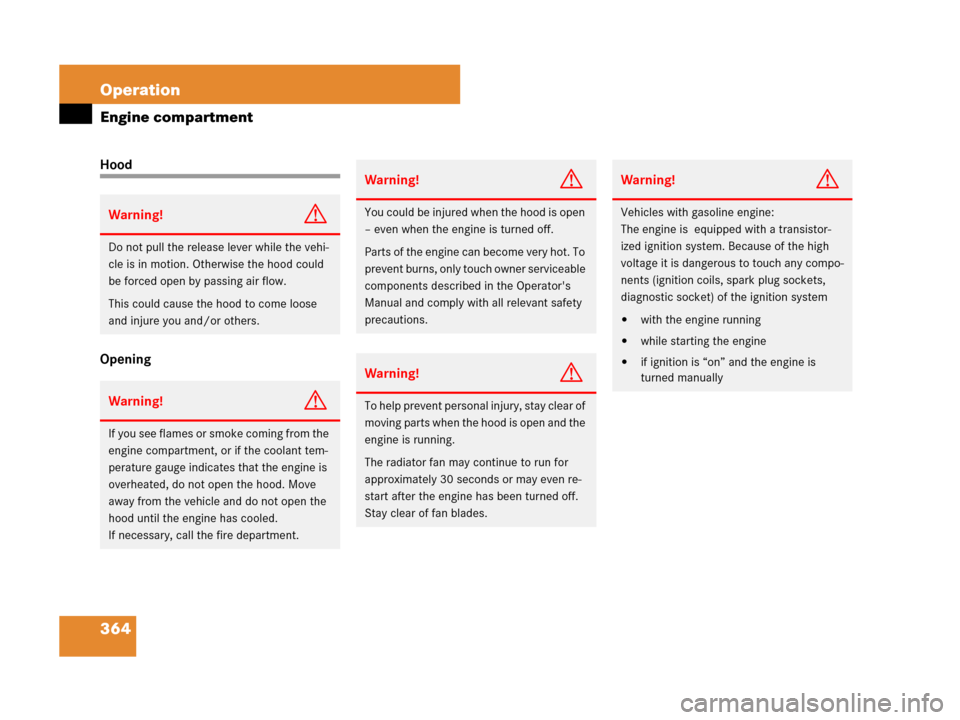
364 Operation
Engine compartment
Hood
Opening
Warning!G
Do not pull the release lever while the vehi-
cle is in motion. Otherwise the hood could
be forced open by passing air flow.
This could cause the hood to come loose
and injure you and/or others.
Warning!G
If you see flames or smoke coming from the
engine compartment, or if the coolant tem-
perature gauge indicates that the engine is
overheated, do not open the hood. Move
away from the vehicle and do not open the
hood until the engine has cooled.
If necessary, call the fire department.
Warning!G
You could be injured when the hood is open
– even when the engine is turned off.
Parts of the engine can become very hot. To
prevent burns, only touch owner serviceable
components described in the Operator's
Manual and comply with all relevant safety
precautions.
Warning!G
To help prevent personal injury, stay clear of
moving parts when the hood is open and the
engine is running.
The radiator fan may continue to run for
approximately 30 seconds or may even re-
start after the engine has been turned off.
Stay clear of fan blades.
Warning!G
Vehicles with gasoline engine:
The engine is equipped with a transistor-
ized ignition system. Because of the high
voltage it is dangerous to touch any compo-
nents (ignition coils, spark plug sockets,
diagnostic socket) of the ignition system
�with the engine running
�while starting the engine
�if ignition is “on” and the engine is
turned manually
Page 371 of 570

370 Operation
Engine compartment
�Unscrew filler cap1 from filler neck.
�Add engine oil as required. Be careful
not to overfill with oil.
Be careful not to spill any oil when adding.
Avoid environmental damage caused by oil
entering the ground or water.
�Screw filler cap1 back on filler neck.
For more information on engine oil, see
“Technical data” section (
�page 538) and
(
�page 540).
Transmission fluid level
The transmission fluid level does not need
to be checked. If you notice transmission
fluid loss or gear shifting malfunctions,
have an authorized Mercedes-Benz Light
Truck Center check the automatic trans-
mission.Coolant level
The engine coolant is a mixture of water
and anticorrosion/antifreeze. To check
the coolant level, the vehicle must be
parked on level ground.
!Excess oil must be siphoned or drained off.
It could cause damage to the engine or
emission control system not covered by the
Mercedes-Benz Limited Warranty.Warning!G
In order to avoid any possibly serious burns:
�Use extreme caution when opening the
hood if there are any signs of steam or
coolant leaking from the cooling system,
or if the coolant temperature gauge indi-
cates that the coolant is overheated.
�Do not remove pressure cap on coolant
reservoir if coolant temperature is
above 158°F (70°C). Allow engine to
cool down before removing cap. The
coolant reservoir contains hot fluid and
is under pressure.
Page 372 of 570
371 Operation
Engine compartment
The coolant expansion tank is located on
the passenger side of the engine compart-
ment.
1Cap
2Coolant expansion tank
3Indicator wall
4Coolant level�Using a rag, turn cap 1 slowly approx-
imately one half turn counterclockwise
to release any excess pressure.
�Continue turning cap 1 counterclock-
wise and remove it.
Coolant level 4 is correct if the level:
�for cold coolant: reaches the top of
indicator wall 3 visible through the
filling opening
�for warm coolant: is approximately
0.6 in (1.5 cm) higher
�Add coolant as required.
�Replace and tighten cap 1.
For more information on coolant, see
“Coolants” (
�page 543).
�Using a rag, slowly open the cap approx-
imately 1/2turn to relieve excess pres-
sure. If opened immediately, scalding
hot fluid and steam will be blown out un-
der pressure.
�Do not spill antifreeze on hot engine
parts. Antifreeze contains ethylene gly-
col which may burn if it comes into con-
tact with hot engine parts.
Page 456 of 570
455 Practical hints
What to do if …
Display symbolDisplay messagePossible cause/consequencePossible solution
•Coolant level
Stop car, switch engine
offThe coolant is too hot.
Among other possible causes
(the cooling fan could be
malfunctioning), the poly-V-belt
could be broken.�Stop the vehicle in a safe location or
as soon as it is safe to do so.
�Turn off the engine.
�Apply the parking brake (�page 66).
�Check the poly-V-belt.
If it is broken:
�Do not continue to drive. Otherwise
the engine will overheat due to an
inoperative water pump which may
result in damage to the engine.
Contact an authorized
Mercedes-Benz Light Truck Center.
If it is intact:
�Wait for the message to disappear
before restarting the engine.
Doing otherwise could result in seri-
ous engine damage that is not
covered by the Mercedes-Benz
Limited Warranty.
(Continued on next page)
Page 457 of 570
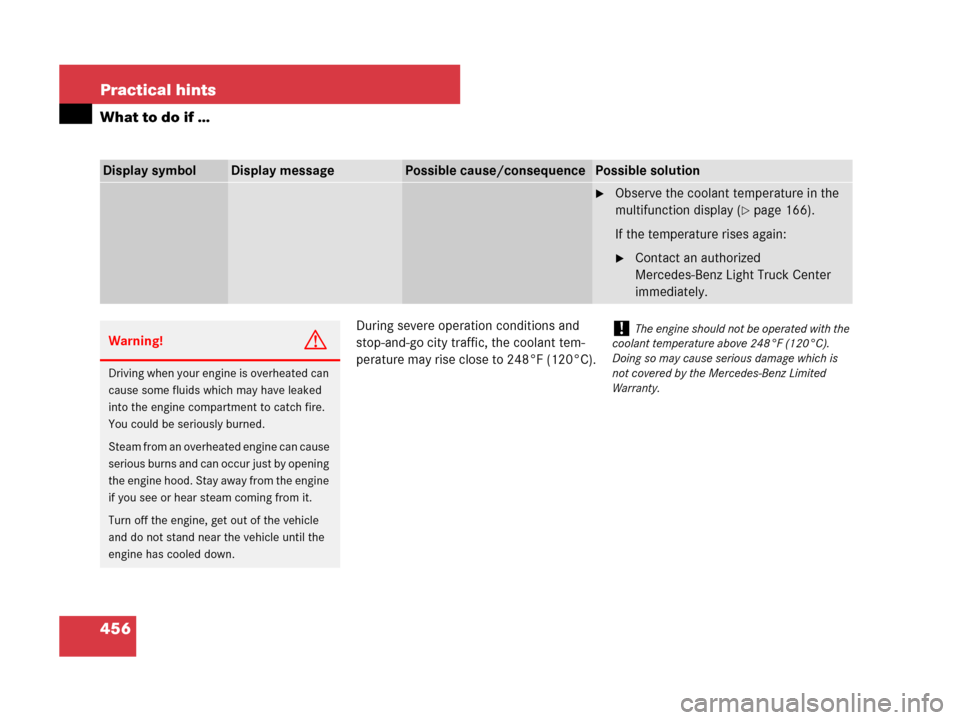
456 Practical hints
What to do if …
During severe operation conditions and
stop-and-go city traffic, the coolant tem-
perature may rise close to 248°F (120°C).
Display symbolDisplay messagePossible cause/consequencePossible solution
�Observe the coolant temperature in the
multifunction display (
�page 166).
If the temperature rises again:
�Contact an authorized
Mercedes-Benz Light Truck Center
immediately.
Warning!G
Driving when your engine is overheated can
cause some fluids which may have leaked
into the engine compartment to catch fire.
You could be seriously burned.
Steam from an overheated engine can cause
serious burns and can occur just by opening
the engine hood. Stay away from the engine
if you see or hear steam coming from it.
Turn off the engine, get out of the vehicle
and do not stand near the vehicle until the
engine has cooled down.
!The engine should not be operated with the
coolant temperature above 248°F (120°C).
Doing so may cause serious damage which is
not covered by the Mercedes-Benz Limited
Warranty.